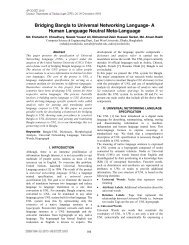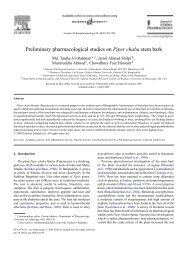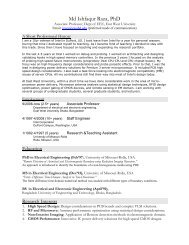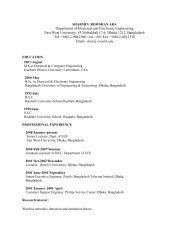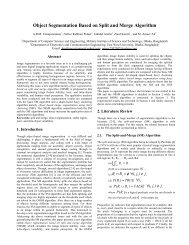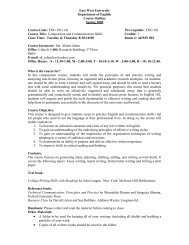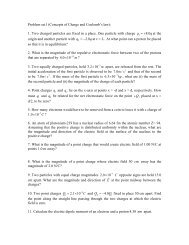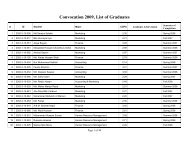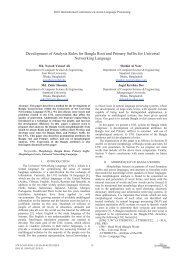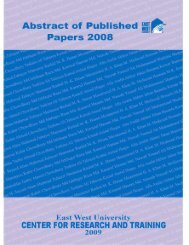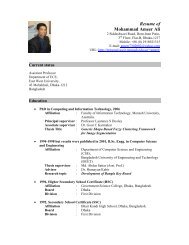Robust Object Segmentation using Split and Merge - East West ...
Robust Object Segmentation using Split and Merge - East West ...
Robust Object Segmentation using Split and Merge - East West ...
You also want an ePaper? Increase the reach of your titles
YUMPU automatically turns print PDFs into web optimized ePapers that Google loves.
neighbor <strong>and</strong> merging any two regions R i <strong>and</strong> R j decreasesthe inter-variance of the image. After application of this test,the stable regions that have minimum variance withinthemselves are obtained. At the same time, their inter-regionvariances are maximized. This test allows finding a globalsolution where the threshold is dynamically updated therebyto eliminate the problems of result anomalies due tothreshold change. However, there are some rare situations inwhich individual cluster can violate these constraints [11].3.3. Concept of Human PerceptionIf the change of any object or feature is less than or equal to0.5dB, human perception is unable to detect the change[17]. Now, let the larger region be R l <strong>and</strong> the smaller regionbe R s . Presence of R s collocated to R l creates distortion. Theregions R s with R l will be merged considering them belongsto the same object if they satisfy the following equation:Rl0.5=20logRs0.5⇒ anti-log( )20Rl⇒ 1.059=R( )=sRlRs⇒ R l =1.059R s (4)Referring (4), it can then be said that for any twoneighboring regions, if the size of one region is less than orequal to 6% of another one, human perception cannotdifferentiate these two regions. This concept can be used toallow the SM to identify any non-patterned shaped objectaccurately without any distortion.4. Proposed ModelTo enhance the performance of segmentation process <strong>and</strong> toaddress the drawbacks of the SM algorithm mentioned inSection 2, this section presents a newly developed robustobject segmentation based on split <strong>and</strong> merge (ROSSM)algorithm based on the basic idea of the SM algorithm. Themain two constituent parts of the ROSSM algorithm are: (i)split stage, <strong>and</strong> (ii) merge stage. Since the splitting is thefirst step of the proposed ROSSM algorithm, it is detailed inthe next section.4.1. <strong>Split</strong> StageIn the split stage, it recursively subdivides a larger regioninto almost equally four sub-regions based on the thresholdvalue which is calculated applying T-test <strong>and</strong> its 95%fiducially limit. This fiducially limit ensures the regionstability. Let R i be a larger region at any instant of splitstage. If the P(R i )=FALSE as mentioned in Section 2, itsub-divides the region R i into four almost equal sub-regionR j where j=1,2, …,4. The idea behind this method is thatsplit stage of it partitions the whole image into numeroussmall regions. The main characteristics of each splittedregion are that they are individually stable in nature asmentioned in Section 3. They may either be a full object ora small part of a full object (i.e. a leaf of 3 intensity levelmay be represented as 3 regions in this stage). In this stagean image is spitted into number of sub-regions, for exampleas shown in the Figure 3. After splitting the image into alarge number of smaller regions, it needs to merge thesplitted regions to form final segmented regions <strong>and</strong> themerge stage is detailed in the next section.(a)(b)Figure 3: (a) Original image, (b) <strong>Split</strong>ted regions of (a)4.2. <strong>Merge</strong> StageThe merge stage of the proposed ROSSM algorithmcontains three main constituent parts which are applied onlyon the connected regions <strong>and</strong> that are: (i) merging on thebasis of T-test, (ii) merging for inter-variance maximization<strong>and</strong> intra-variance minimization, <strong>and</strong> (iii) merging regionsconsidering human perception. Since the merging of regionson the basis of region stability is the first step of theproposed ROSSM algorithm, it is detailed in the nextsection.4.2.1. Merging on the basis of stability testAny two connected regions are qualified to be merged ifthey are both stable i.e., these two regions are within the99% fiducially limit of T-test. The idea behind this mergingis to combine those parts of an object which wereunexpectedly separated due to hard partitioning in the splitstage. Moreover, if two connected regions having aminimum combined intra variance are chosen for mergingto form a larger region, the merging would be more fruitful.This issue is already discussed in section 3.2. This processwill continue until any region satisfies to be merged underthe criteria of T-test. After completion of merging on thebasis of T-test, regions obtained are stable in nature. Theymay either be a full object or a stable part of an object. Atthis stage, there may exist some stable parts of objectswhich are not still merged. To merge these components ofobjects, the following technique is applied.4.2.2. Merging for Inter-variance Maximization <strong>and</strong>Intra-variance Minimization



